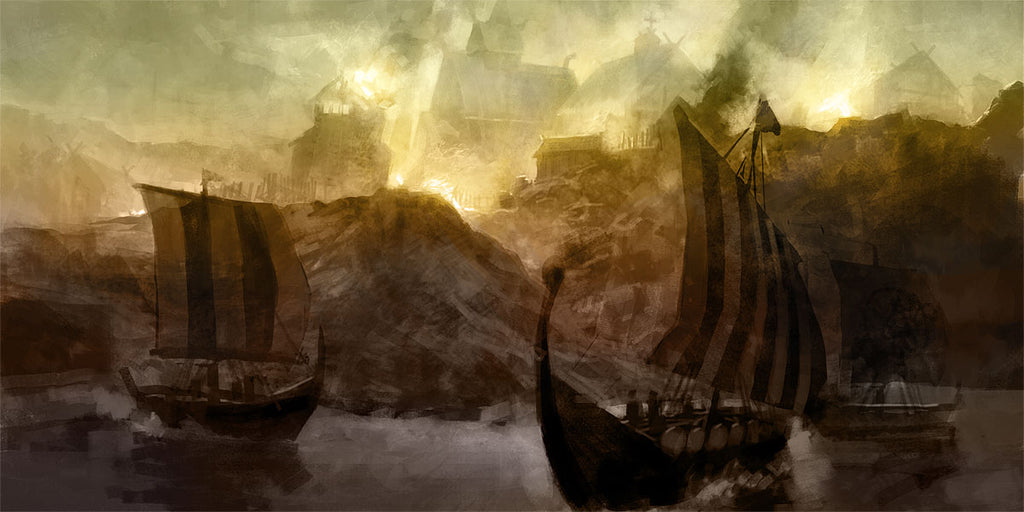On This Day 8th June, The Vikings Attacked Lindisfarne of Northumbria
Viking attack on Lindisfarne is considered one of the most famous and earliest raids in England sending waves of shock to Anglo-Saxon England as well as Christians in general. 8th June 793 unfolded the story of Viking nightmare.
Many claims pointed that Viking attack on Lindisfarne ignited the Viking Age. Yet, the truth was, Viking Age started long before this attack. But it was definitely a turning point not only for the Vikings but also for the whole world, marking the beginning of raiding, pillaging, empire-building, and influencing process of the Norsemen.
The fierce warriors aimed at the Lindisfarne monastery which was not only a holy place for the Christians but also rich in treasure and gold.
This raid was a shocking and unexpected event. It didn't befall England but the southern part of Saxon kingdom of Northumbria. Historians believed that Northumbria was in political turmoil. There was a rising force from the North warriors and to the south of Northumbria was a new power centre. This demanded the ruler of Northumbria to be a capable warrior to handle this tough place.
Aethelred I, who was the King of Northumbria when Viking attack befell, was just back to his throne after his exile. He was blamed by the favourite scholar of Charlemagne, Alcuin of York, for bringing this punishment to Anglo-Saxon.

The Vikings attacked Lindisfarne which was seen as the land of God for the Christians
This scholar wrote a letter blaming that it was Aethelred who brought the punishment of God to Northumbria.
Regarding the Vikings, they embarked on their raiding voyages because of many factors. It was because of the overpopulation that led the Vikings to the point that their ancestral land wasn't enough. New technology and demand for trade were contributing factors to Viking raid. All together, these men from the north set sail.
Indeed the Vikings were fierce warriors. But they were also the most excellent shipbuilders at that time which allowed them to have a permanent edge over their enemies. These boats helped them to quickly hit the target and leave within a short period of time.

Viking warriors raided Lindisfarne 793. Cre: "Vikings" TV series
But the media didn't exist in Lindisfarne in 793 and those who lived in Lindisfarne probably had no ideas about the North warriors. Back then, this island was the holy centre of Christianity.
By far, the historians are still debating whether this attack was a stroke of sheer luck or it was a well-organized plan. Because Northumbria lay perfectly off the coast where the Vikings could easily leave after raiding. And it was too far away from the military army and by the time the army reached Lindisfarne, the Vikings had left. Maybe because the Northumbrians regarded this place a sacred land so they assumed no one dared to wield their sword in the land of Jesus. The most important thing for the Vikings was that this place was wealthy and full of treasure. As the Christians devoted gold and silver to the monastery, it was stuffed with treasure.
The Anglo-Saxon Chronicles once described the attack:
793 AD. This year came dreadful fore-warnings over the land of the Northumbrians, terrifying the people most woefully: these were immense sheets of light rushing through the air, and whirlwinds, and fiery dragons flying across the firmament. These tremendous tokens were soon followed by a great famine: and not long after, on the sixth day before the ides of January in the same year, the harrowing inroads of heathen men made lamentable havoc in the church of God in Holy-island, by rapine and slaughter
(...)
Never before has such terror appeared in Britain as we have now suffered from a pagan race … The heathens poured out the blood of saints around the altar, and trampled on the bodies of saints in the temple of God, like dung in the streets
Lindisfarne was neither the first nor the last place for Viking raid. In the Anglo-Saxon Chronicle, four years before the Lindisfarne attack, the Vikings once attacked the Saxon Kingdom of Wessex. 792 AD witnessed a Viking attack on Merica and built a settlement there. In the following years, m monasteries Monkwearmouth and Jarrow were attacked by the Vikings and monastery of St. Columba in 795 AD.
To be fair, 8th June 793 was a bad day for the Northumbrians but a great for the Viking warriors who were brave enough to embark on a new journey of their age. It was a launch pad for the Viking warriors.




